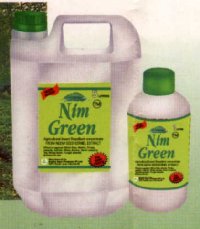NEEM-IN AGRICULTURE
Usually, the insecticides were quick-acting
nerve toxins designed to kill any insect, including beneficial insects
like bees, on contact. Although they are targeted at insects, the broad-spectrum
insecticides can harm any creature that lives in or passes through areas
in which they have been sprayed. This includes earthworms, birds, squirrels,
dogs, cats and even people. Most manufacturers of insecticides used in
the yard recommend waiting three days before walking barefoot on the sprayed
areas and to keep pets and children away for at least that long.
People living as much as a quarter mile away
from the insecticide application can be affected by evaporated insecticide
and aerosols drifting in the air. In some individuals, this can result
in severe reactions like headaches and numbness in the limbs. In others,
it can cause less noticeable effects that might never be connected with
the true cause of the reaction: toxic insecticides being applied somewhere
in the neighborhood.
 Neem's
natural properties pose no danger of toxic reactions. The seeds and leaves
of the neem tree are the source of a new class of "soft" pesticides.
The term "soft" pesticide is used because no other word quite
fits this remarkable product. The main mode of action is as an anti-feedant.
Insect pests usually refuse to eat any plant covered with neem and do so
until they starve to death. Other effects are as a repellent and a reducer
of an insect's ability to reproduce.
Neem's
natural properties pose no danger of toxic reactions. The seeds and leaves
of the neem tree are the source of a new class of "soft" pesticides.
The term "soft" pesticide is used because no other word quite
fits this remarkable product. The main mode of action is as an anti-feedant.
Insect pests usually refuse to eat any plant covered with neem and do so
until they starve to death. Other effects are as a repellent and a reducer
of an insect's ability to reproduce.
Elimination of the insect pest occurs not by
quick poisoning, but by starvation and drastic reductions in offspring.
Birds and beneficial insects, which are not affected by neem, then feed
on the remaining weakened pests and the small number of remaining offspring.
The result is an almost-immediate halt to plant damage -- without poisoning
the environment.
Neem is non-toxic to animals or people. Areas
sprayed with neem are not poisonous areas to be avoided for days as are
those sprayed with the typical synthetic insecticides. Neem is also a natural,
biodegradable product. Only insects that eat plants are affected by neem,
leaving honeybees and other beneficial insects essentially unharmed. In
fact, in those areas sprayed with neem, the average size and number of
earthworms is greater than in unsprayed areas.
The most active insecticidal compound found
in neem is azadirachtin which acts as an anti-feedant. Azadirachtin causes
insects to refuse to eat plants sprayed with neem. Insects will land and
crawl on the plants but will refuse to eat as long as the azadirachtin
is on the plant. In early tests of neem extracts, the desert locust, which
is known for its voracious appetite, refused to eat any plants sprayed
with neem and eventually starved to death surrounded by its favorite food.
As important as azadirachtin is, neem's true
effectiveness comes from the interaction of all of the compounds which
affect different aspects of an insect's life. Other compounds act as insect
repellents, cause insects to lay sterile egg cases, prevent molting, and
others simply enhance the effects of other compounds. The number and complexity
of the compounds found in neem that affect insects make resistance to neem
highly unlikely. This is extremely important as insects are rapidly developing
resistance to the major synthetic insecticides. More and more insects are
even developing resistance even to natural bacterial controls like Bacillus
thuringensis (Bt).
Synthetic pesticides are less expensive in
the short run, but factoring in their total impact dramatically increases
their true long-term cost.
Neem has been found to be beneficial to bees.
Bees are coming under assault on several fronts. There are mites and diseases
that cause bees to produce less pollen and honey and to become sick and
die. Neem treated bees showed reduced levels of Nosema and chalkbrood even
over bees treated with the most current medicines and miticides. The neem
treated bees produced three times as much pollen and twice the amount of
honey as the non-treated bees.
Home
 Neem's
natural properties pose no danger of toxic reactions. The seeds and leaves
of the neem tree are the source of a new class of "soft" pesticides.
The term "soft" pesticide is used because no other word quite
fits this remarkable product. The main mode of action is as an anti-feedant.
Insect pests usually refuse to eat any plant covered with neem and do so
until they starve to death. Other effects are as a repellent and a reducer
of an insect's ability to reproduce.
Neem's
natural properties pose no danger of toxic reactions. The seeds and leaves
of the neem tree are the source of a new class of "soft" pesticides.
The term "soft" pesticide is used because no other word quite
fits this remarkable product. The main mode of action is as an anti-feedant.
Insect pests usually refuse to eat any plant covered with neem and do so
until they starve to death. Other effects are as a repellent and a reducer
of an insect's ability to reproduce.